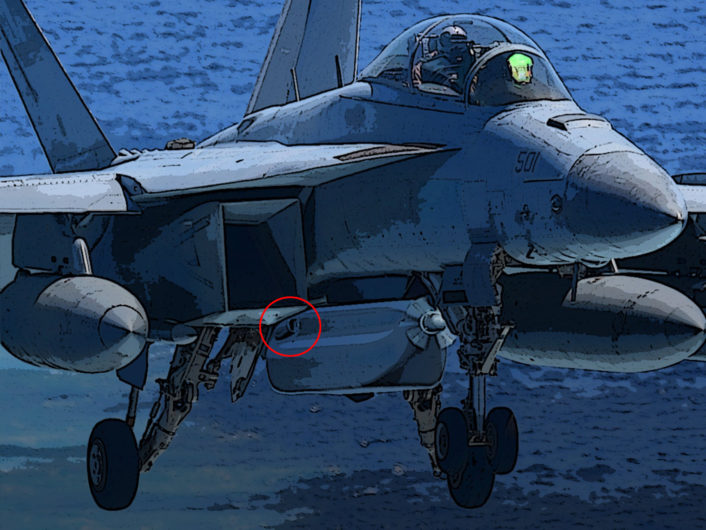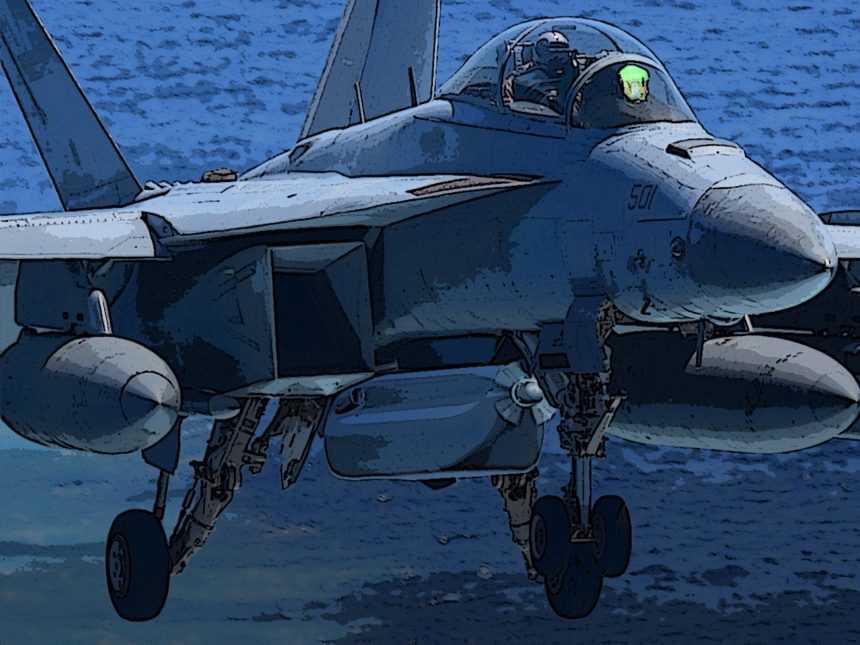The NGJ-LB system will replace the current, aging AN/ALQ-99 Tactical Jamming System (TJS).
The NGJ (Next Generation Jammer) is a U.S. Navy program to augment, and ultimately replace the EA-18G Growler aircraft’s aging ALQ-99 TJS developed in the 1970s for the EA-6B Prowler (a type that has been completely retired from active service in March this year).
The NGJ program aims to give the EA-18G fleet advanced airborne electronic attack capabilities through three frequency-focused increments – high-band, mid-band and low-band: in other words, the Growlers will replace the TJS pods operating in the 509 MHz to 18 GHz waveband, using three different pods, designated NGJ-LB (also known as Block/Increment 2), NGJ-MB (Capability Block/Increment 1), and NGJ-HB (Block/Increment 3) and directed specifically against the low- (100 MHz to 2 GHz waveband), mid- (2 GHz to 6 GHz), and high-band (6 GHz to 18 GHz) sections of the overall threat spectrum.
As we have already reported, the first Engineering and Manufacturing Development (EMD) pod, a test article used to perform ground and aircraft integration testing, of the Next Generation Jammer Mid-Band (NGJ-MB) or Increment 1 pod was delivered by Raytheon to the U.S. Navy last August and has been mounted on an EA-18G Growler of the Air Test and Evaluation Squadron (VX) 23 Growler at Naval Air Station Patuxent River, Maryland, to start mission systems testing and qualification.
On Jan. 16, 2020, Northrop Grumman submitted its proposal for the US Navy’s Next Generation Jammer (NGJ) Low Band (LB) Capability Block 1 (CB1) competition, whose deadline was Jan. 17. Although Northrop Grumman and L3 Harris are already going head-to-head building competing Low Band jammer pod prototypes for test and demonstration under the NGJ-LB Demonstration of Existing Technologies contract the new proposal deals with the most important part of the project: the first installment of the Next Generation Jammer-Low Band suite. This is a big deal since whoever is awarded the contract, it will become prime designer/developer/producer/integrator for the future Low Band jammer on the EA-18G Growler.
“The NAVAL AIR SYSTEMS COMMAND (NAVAIR) is issuing a full and open solicitation for a Cost Plus Incentive Fee (CPIF) contract for the NGJ LB Capability Block 1 (CB1) phase of the Next Generation Jammer (NGJ) program. The contract will include the design, development, build, integration, test, and maintenance (of the test assets) of a complete solution for low band capability, including two (2) Captive Mass Model Aeromechanical Pods, four (4) Jettison Mass Model Pods, two (2) Mission System Prototype Test Pods, eight (8) Operational Prototype Pods, two (2) Technique Development Stations and ten (10) Pod Simulators.”
“Northrop Grumman has submitted our proposal for the Next Generation Jammer Low Band (NGJ LB) Capability Block 1 (CB1) solution,” said Curtis Pearson, Director, Advanced Programs, Northrop Grumman, in an official statement. “Since being selected by the U.S. Navy in October 2018 for the Next Generation Jammer Low Band Demonstration of Existing Technologies (DET) program, our Growler and electronic warfare (EW) mission teams have committed to meeting the Navy’s speed to fleet path. The industry-government team for Low Band have partnered closely on research, design, development, production, integration and test to deliver a complete solution for low band capability. As the Electronic Attack integrator on the EA-18G Growler, we will continue to work closely with the Navy to deliver solutions that maintain warfighter advantage for the EW mission.”
Therefore, while NGJ-MB will replace one of high-band ALQ-99 pods that Growlers carry under each wing, the NGJ-LB, will replace the low-band pod that the aircraft carry on the centerline store position under the fuselage (the third one, a high-band pod, being developed as part of the so-called Increment III, will be carried on the left wing). The NGJ-LB will be extremely important to provide cover to stealth aircraft, threatened by the emerging counter-stealth Low Band radars, engaging enemy threats from increased stand-off distances and employing increased capacity (number of jamming assignments).
Once again, here’s what I’ve explained about the F-35 and the low-band radars in this past article:
In fact, tactical fighter-sized stealth aircraft are built to defeat radar operating at specific frequencies; usually high-frequency bands as C, X, Ku and S band where the radar accuracy is higher (in fact, the higher the frequency, the better is the accuracy of the radar system).
However, once the frequency wavelength exceeds a certain threshold and causes a resonant effect, LO aircraft become increasingly detectable. For instance, ATC radars, that operate at lower-frequency bands are theoretically able to detect a tactical fighter-sized stealth plane whose shape features parts that can cause resonance. Radars that operate at bands below 300 MHz (lower UHF, VHF and HF radars), such as the so-called Over The Horizon (OTH) radars, are believed to be particularly dangerous for stealth planes: although they are not much accurate (because lower frequency implies very large antenna and lower angle accuracy and angle resolution) they can spot stealth planes and be used to guide fighters equipped with IRST towards the direction the LO planes might be.
Unlike the NGJ-MB pod, that uses two sets of door to allow ram air to enter and exit while emitting, based on the artist rendering Northrop Grumman has just released [that appears to be based on an actual photo (with some photo filter applied to it)], their NGJ-LB design will feature the typical front propeller of the RAT (Ram Air Turbine) as used in the ALQ-99 to generate power. Noteworthy, the new image of the centerline pod shows a slightly modified design than the original version that circulated last year, with the addition of what seems to be a small air intake on the upper rear section of the pod (whose shape is, for the rest, similar to the one of the ALQ-99).









